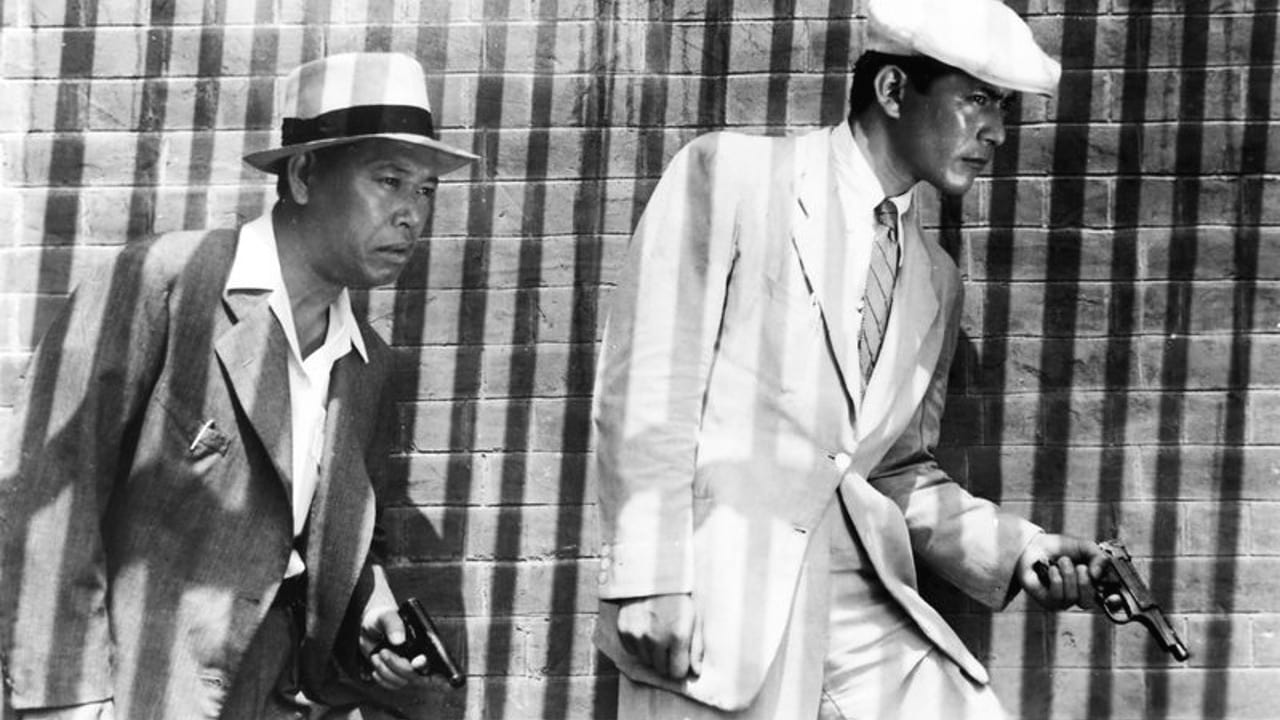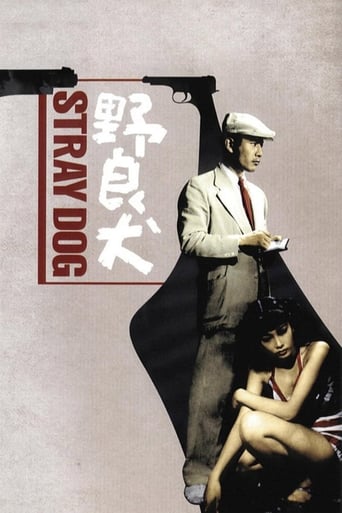

This movie is the proof that the world is becoming a sick and dumb place
... View MoreA movie that not only functions as a solid scarefest but a razor-sharp satire.
... View MoreThis film is so real. It treats its characters with so much care and sensitivity.
... View MoreOne of the worst ways to make a cult movie is to set out to make a cult movie.
... View MoreKurosawa is one of my pet dislikes - the samurai stuff leaves me cold, the social dramas seem off the mark, and the crime capers just dreary. Part of the problem is that the man is humourless - I don't think I've seen a funny Kurosawa film, or even a funny moment. Still, here at last is something endurable. I had to overlook quite a lot in order to get to like this film but it was worth shifting aside the garbage to appreciate the gems.Again, there is no humour here, only a silly story about a rookie cop who has his gun stolen, resulting in a hunt for the lost article whose weary obsessiveness is as horribly monomaniacal as Bicycle Thieves. The cop, Toshiro Mifune (the big guy from the Seven Samurai), has a face like a young Gregory Peck but a personality so melodramatically emotional that we wonder if he should be resting in some kind of institution. The senior cop is - oh Christ - it's Takashi Shimura, the old git from Ikiru. About half an hour in, I'm seriously thinking of giving up. They've gone looking, on a hunch, for a guy in a baseball stadium - they find him among 50,000 people. I'm thinking: I'd much rather watch a version where they don't find him.None of this bodes well, but then Kurosawa - as if he really believes in this stuff - starts to crank out some pretty impressive scenes. We notice we are constantly peering through things and between things, through window frames into hovels, through smudgy glass doors, rainy windows, gauze curtains skeined with flowers, billows of smoke - all done in the ravishing von Sternberg manner.We note that, instead of choreography, he places people strategically within a frame, drawing diametric patterns with faces scattered within a room, and lets the compositions -always elegant and effective - relate the meaning. In particular, there are portraits of two women from the sleazy underworld that stand out - he really lavishes attention on them and it does the film the world of good because the cops have long become tiresome.The weather is close and the tension is building (way too much mopping of the brow from Shimura) - an old trick to build atmosphere, but it does provide the opportunity for several climactic scenes that run concurrently as the storm breaks.The story is worthless, but watch it for the technique.
... View MoreDuring a sweltering summer, a rookie homicide detective tries to track down his stolen Colt pistol. The film is considered a precursor to the contemporary police procedural and buddy cop film genres.Kurosawa mentioned in several interviews that his script was inspired by Jules Dassin's "The Naked City" and the works of Georges Simenon. Kurosawa wrote the script with Ryūzō Kikushima, a writer who had never written a script before. Indeed, it would be hard to deny the influence that film noir had on this film, as it is essentially that: film noir set in a post-war Tokyo.I have to wonder what influence this film had , if any, on the Nikkatsu studio. They made many great gangster films in the 1950s and 1960s, and while there is a distinction between "film noir" and "gangster", there is enough overlap that surely "Stray Dog" must have been something that was in the back of their minds.
... View MoreThis would be probably my least favourite of all kurosawa films because I believed Kurosawa at that point still had a lot to learn on how to make a really good detective drama -- though it is understandably about a rookie detective who has no clear idea of how to conduct his job properly (chasing after an armed criminal without backup is one example), I cannot accept that even with the whole experienced police force around there is such a lack of seriousness and professionalism in their conduct, also the logic of Takashi's deduction methods was totally unexplainable.There is also a severe lack of focus on the villain ...but this is forgivable as the film is made from the detectives' point of view and the subject matter of the film is actually the rookie himself. Mifune's dummy acting is probably the weakest one I have seen so far. However the strength of this film lies not in the characters nor plot, but it is the setting that has nothing to do with the story. I found myself more fascinated by the music and the environment in the background, especially during certain prolonged scenes of 'investigation'...which gave some idea of a real life post-war japan. It ended up looking more like a documentary in the end, and didn't work for me.Domo gomenasai, kurosawa-sama!
... View MoreBoy oh boy, I'm a bit ashamed for this but nevertheless I have to point out that when I watched the Criterion DVD of STRAY DOG last Saturday night it was just my second encounter with the work of one of the, so called, true masters. With that said, I have to start saying that STRAY DOG begins in a way I would not have expected from a Kurosawa film: with a voice-over godlike narration. It sort of make you think that this Kurosawa film will be like a bit more "normal", I mean like a straight detective picture from the 40s. It can be seen as that but you would have to add the classic "but it is much more than just a straight detective picture". I found three scenes that are sort of the key to that. Obviously the first one is when our main character, Toshiro Mifune's Murakami (a rookie homicide detective), enters to the sort of ghetto town. Here the plot is simple: rookie detective suffered the attack of a pickpocket, who stole his gun. Half pay for some time and lost pride are some of the things that this brings. Indeed a terrible thing for Murakami. So he is there seeking for his gun in the most traditional detective way. And when the traces lead him to that sort of ghetto town you get the most unexpected. I call it patience. We witness Kurosawa's patience as he basically filmed like 10 minutes of Murakami seeing the horrors of that place. You need to be a patient viewer, is good stuff but certainly not for the fan of noisy stuff. So you know Kurosawa is into more, he's a filmmaker who announces at the beginning of his film, though his narrator, that this story is set during a heat wave, and who will remark you that all the time and even occupy like 3 minutes to simply show that (that scene when we see the dancers sweat). It's great how all of that makes truly unforgettable that STRAY DOG is a film set during a heat wave. I'm a huge fan of the TV show from Baltimore THE WIRE. And I recalled the show with this film. Good police work is shown here. The one that truly satisfy the viewer, or at least a viewer like myself. Plus we have great characters. Takashi Shimura, as Murakami's partner (the experimented detective Sato), is fantastic. Scenes like the one when both detectives leave the work for a while and go to Sato's place are as simple as fantastically satisfying. STRAY DOG success as it keeps you always interested. Can't wait to check out some more of these Kurosawa-Mifune-Shimura collaborations!
... View More